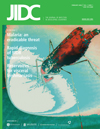Comparison of polymerase chain reaction and conventional methods in detecting methicillin-resistant Staphylococcus aureus
DOI:
https://doi.org/10.3855/jidc.321Keywords:
Methicillin-resistant Staphylococcus aureus (MRSA), polymerase chain reaction (PCR), oxacillin disk diffusion, cefoxitin disk diffusion, oxacillin agar screeningAbstract
Background: Accurate and rapid detection of methicillin-resistant Staphylococcus aureus is very important in a clinical laboratory setting to avoid treatment failure. Conventional methods were compared against the gold standard polymerase chain reaction (PCR) technique to determine the best combination of the routine procedures. Methodology: Methicillin resistance was investigated in 416 clinical Staphylococcus aureus isolates by PCR, oxacillin agar screening (OAS), oxacillin disk diffusion (ODD) and cefoxitin disk diffusion (CDD) methods. Results: Two hundred and ten (51%) out of 416 S. aureus strains were found to be mecA-positive by PCR. Sensitivity and specificity of the ODD, CDD and OAS methods were detected as follows: 100% and 89%, 99.50% and 100%, and 99.50% and 100%, respectively. Conclusion: Combining the ODD and CDD methods could be a good choice for detecting methicillin resistance in S. aureus strains where mecA PCR cannot be performed.Downloads
Published
2008-02-01
How to Cite
1.
Adaleti R, Nakipoglu Y, Karahan ZC, Tasdemir C, Kaya F (2008) Comparison of polymerase chain reaction and conventional methods in detecting methicillin-resistant Staphylococcus aureus. J Infect Dev Ctries 2:046–050. doi: 10.3855/jidc.321
Issue
Section
Original Articles
License
Authors who publish with this journal agree to the following terms:
- Authors retain copyright and grant the journal right of first publication with the work simultaneously licensed under a Creative Commons Attribution License that allows others to share the work with an acknowledgement of the work's authorship and initial publication in this journal.
- Authors are able to enter into separate, additional contractual arrangements for the non-exclusive distribution of the journal's published version of the work (e.g., post it to an institutional repository or publish it in a book), with an acknowledgement of its initial publication in this journal.
- Authors are permitted and encouraged to post their work online (e.g., in institutional repositories or on their website) prior to and during the submission process, as it can lead to productive exchanges, as well as earlier and greater citation of published work (See The Effect of Open Access).








